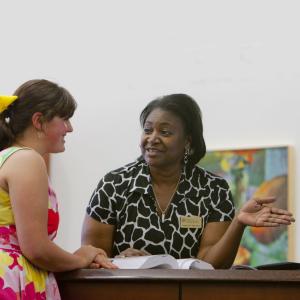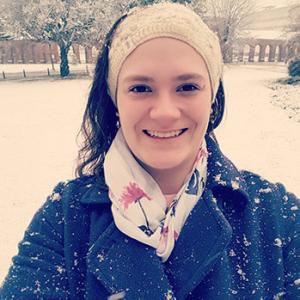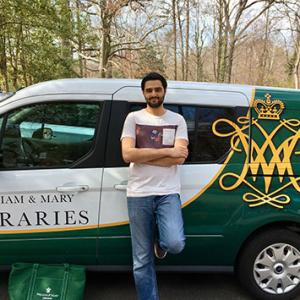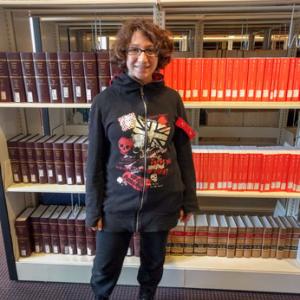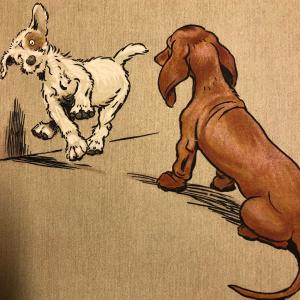There is no doubt that the Williamsburg area is steeped in history. From the first permanent British settlement in the U.S. at Jamestown to the battlefield at Yorktown, and of course Colonial Williamsburg right next to the William & Mary campus, the area it is truly America's Historic Triangle.
Archive
Archive
- When people meet me, they often ask what I do, and when I give them my title, Digital Scholarship Librarian, they are just as unclear on my job duties as before they asked. Then, I flesh out the role a bit more. Essentially, I work to promote and support scholarship which goes on around campus.
- Last week, I had the opportunity to meet HRH Prince Richard, Duke of Gloucester and show him some of the rich materials held in Special Collections. I wanted to make sure to highlight the dog book collection, and I came across titles related to HRH's grandfather, King George V, as well as his first cousin, Queen Elizabeth II. Of the ones I chose to display, the following titles are my favorites.
- Many students are intimidated by making a research appointment because they don't know what will or can happen. I'm here to dispel the myths and rumors around the conundrum that is the Research Appointment. This blog post will be the first in a series about how we conduct our Research Appointments.
- Recently I had the opportunity to attend a conference at Radford University called The Innovative Library Classroom, or TILC. Radford University which is in, yep, you guessed it, Radford, Virginia, is about 270 miles from Williamsburg; therefore, road trip! The route from Williamsburg went along Interstate 64 and then south on Interstate 81.
- The quotation in the title of this post is from a letter about an 1890 revolution in Buenos Aires known as The Revolution of the Park.
- My name is Elisabeth Merrifield. Yes, it is spelled with an 's' and not a 'z' mainly because my parents did not want me to be called 'Liz' (it did not work). I am a senior at the College. I am double majoring in government and history. I transferred in the Fall of 2015 and have loved it here. I play for the Gold Women's Club Volleyball team and love my team. They are outstanding and ridiculously smart people.
- Did you know that May is National Photography month? Well if you didn't, now you do! I bet you're wondering -- what sorts of resources does Swem have for budding young students of photography?
- This month's "Must Love Dogs" blog series again focuses on an illustrator.
- I started working at Swem in my very first week of freshman year and fell in love with the place immediately. On my first day, I wandered the library to fill out a scavenger-hunt-esque training exercise that introduced me to the labyrinth of books that serves as the cultural capital of our campus. The building really does it all.
- Hello lovely people! My name is CeeCee and I'm a Student Associate in the Circulation department here at Swem.
- Hi everyone! My name is Zihan Yang, most people know me as Carrie. I'm an international student from China and this is my third year at William & Mary (how time flies). Back home, I love to spend my free time at my high school's library and the public library, so when I came to college, the first place I went to check out was the library. I immediately fell in love with our Swem library because it's so beautiful and resourceful.
- Hiya everybody! I'm Shana Merker, a junior music and biology major, and I work as a student assistant in Content Services.
- Hey, fellow Swem-goers! My name is Alexis and I have been working at Swem Circulation for over a year now. I started out as an assistant, shelving and sorting from the books needed for final papers. Last year, I was able to help deliver books to professors all over campus. And as it turns out, books can bring more excitement when you get to drive them in a golf-cart, trying not to get stuck behind tour groups (otherwise known as flamingos).
- I became William & Mary Libraries' Science Librarian on December 25th, 2017. In my first four months of employment I've had several people (including my family members) ask me: "So what exactly does a science librarian do?" It's a great question!
- As an Exhibit Apprentice in Swem's Special Collections, I had the opportunity to curate a World War I centennial exhibit.
- In my first two years at W&M, I rarely went to Swem. It was crowded and busy and stressful, and I preferred the coziness of my own room. But for the past year and a half, I have stepped into Swem hundreds of times, more than my freshman self could have possibly imagined.
- Cecil Aldin (1870-1935) was a British artist and illustrator, famous for his portrayal of dogs.
- William & Mary Libraries is proud to bring back the Art+Feminism Wikipedia edit-a-thon on Tuesday, April 10 from 12 p.m. to 4 p.m. and Wednesday, April 11 from 4 p.m. to 8 p.m. during National Library Week.
- Hi, I'm Azana Carr, and I work as a student assistant for the W&M Libraries External Relations office. The best way to describe my job is: "You know all the events, workshops, and therapy dogs that happen in Swem? We do that!"





